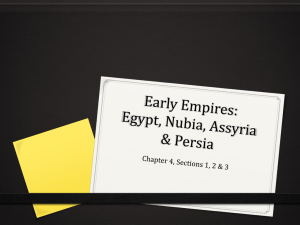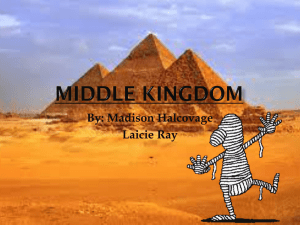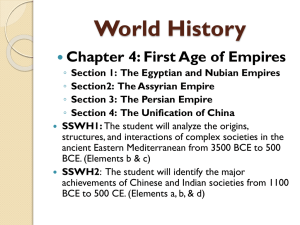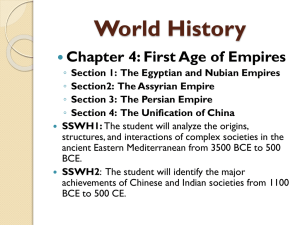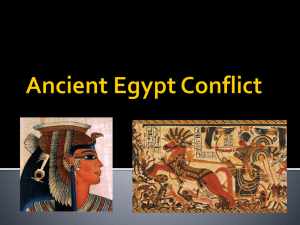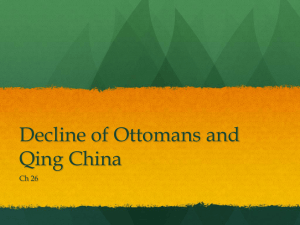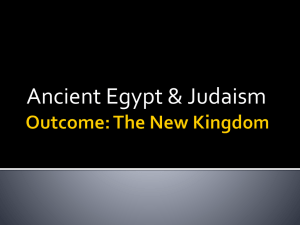Chapter 4 First Age of Empires, 1570 B.C.–200 B.C.
advertisement
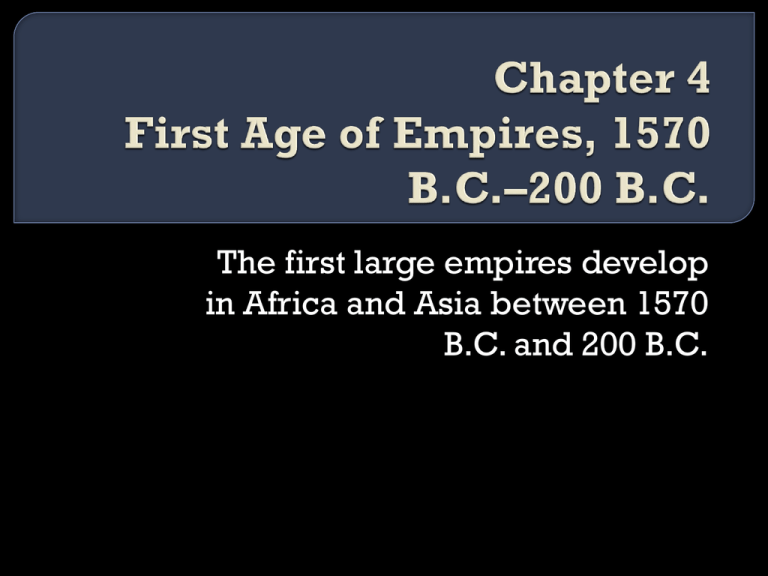
The first large empires develop in Africa and Asia between 1570 B.C. and 200 B.C. Section 1: The Egyptian and Nubian Empires Section 2: The Assyrian Empires Section 3: The Persian Empire Section 4: The Unification of China Two empires along the Nile, Egypt and Nubia, forge commercial, cultural, and political connections. As we learned in Chapter 2, Egyptian civilization developed along the Nile. It eventually developed into a kingdom around 3100 B.C. Egypt became rich from trading with Mesopotamia and the Indus Valley. South of Egypt a major kingdom in the Nubian region, Kush, began to develop and trade with Egypt. Nomadic Invaders Rule Egypt After the prosperity of the Middle Kingdom, Egypt descended into war and violence. Egypt became weak from the war and violence, power struggles within the nobility, and weak pharaohs. • About 1640 B.C., Asian warriors, the Hyksos, use chariots to conquer Egypt. Hebrews Migrate to Egypt • Hebrews move to Egypt from Canaan around 1650 B.C. • Hyksos invited them in because they were similar races. • Egyptians would come to resent the presence of Hebrews and Hyksos in Egypt, but were powerless to remove them. Expulsion and Slavery • Powerful war leaders rise in Egypt and are eventually able to restore power for Egyptians • Egyptians eventually drive out the hated Hyksos to Sinai peninsula. • Hebrews lose protection of Hyksos and become enslaved After overthrowing the Hyksos the pharaohs looked strengthen Egypt. • About 1570 to 1075 B.C. pharaohs create New Kingdom, a powerful empire, it became wealthier and more powerful than ever before. • Partially this happens because the army used bronze weapons and chariots to conquer other lands. The Egyptian army consisted of archers, charioteers, and foot soldiers. Hatshepsut’s Prosperous Rule One of the rulers of the New Kingdom was Hatshepsut. • Hatshepsut—pharaoh whose reign most noted for her trade expeditions, not war. She took over because her stepson, the heir to the throne was just a young child at the time. Thutmose the Empire Builder •Thutmose III, was Hatshepsut’s stepson. He expanded Egypt’s empire. He was a much more war-like ruler. • Invades Palestine, Syria, and Nubia region around the upper Nile River. • Egypt most powerful and wealthy during reign of New Kingdom pharaohs, like Thutmose. The Egyptians and the Hittites Egypt’s conquest of parts of Syria and Palestine around 1400 B.C. bring them into conflicts with the Hittites. • Around 1285 B.C. Egyptians battle the Hittites in Palestine • Egypt’s pharaoh, Ramses II, and the Hittite king sign a peace treaty An Age of Builders • Just like those of the Old Kingdom, the New Kingdom pharaohs built great palaces, magnificent temples • Valley of the Kings near Thebes is home to royal tombs • Ramses II built impressive temples with enormous statues of himself The empire built Thutmose III and Ramses II would soon be challenged by other strong civilizations. Invasions by Land and Sea • “Sea Peoples” (possibly Philistines) invade Egypt and cause great destruction. • Libyan raids on villages and Palestine rebellions weaken empire greatly. Egypt’s Empire Fades • After the invasions, the weakened empire breaks into smaller kingdoms. Egypt’s smaller kingdoms eventually fall to the Libyans. • From around 950 to 730 B.C. Libyan pharaohs rule Egypt, erect cities. Egypt and Kush • From 2000 to 1000 B.C., Egypt dominates kingdom of Kush in Nubia. As Egypt fell into decline during the Hyksos period, Kush began to emerge as a regional power. Kush would eventually establish its own Kushite dynasty on the throne of Egypt. The People of Nubia • Lived south of Egypt near division of Blue Nile and White Nile • Nile River is a great trade route for goods and ideas • Nubians linked Egypt and Mediterranean to African interior through trade The Interaction of Egypt and Nubia During the New Kingdom, pharaohs forced Egyptian rule on Kush. • Egyptian culture influences Nubia and beyond to southern Africa • About 1200 B.C., Nubia gains independence but keeps Egyptian culture, to protect the culture from the Libyans. Piankhi Captures the Egyptian Throne • In 751 B.C., Kushite king Piankhi conquers Egypt, ousts Libyans, united entire Nile Valley. • Assyrians, a war-like people, would overcome Kushites and take Egypt. Forcing the Kushites to retreat back to the southern part of the Nile. Meroë • After defeat by the Assyrians, Kushites settle in Meroë; there they join in trade with Africa, Arabia, India The Wealth of Kush • Meroë becomes important center for iron weapons and tools, because of a large amount of iron ore. • Iron products transported to Red Sea, exchanged for luxury goods The Decline of Meroë • Meroë thrives from about 250 B.C. to A.D. 150, then declines • Aksum, 400 miles southeast, dominates North African trade • Like Kush, Aksum has a port on Red Sea, and would defeat Meroë in A.D. 350. Assyria developes a military machine and establishes a well-organized administration. For more than two centuries, the Assyrian army advanced across Southwest Asisa. It overwhelmed its enemies with military strength. The Assyrians would even eventually sieze control of Egypt after defeating the Kushites. Assyria uses military might to acquire empire across Southwest Asia, making it the greatest power there. The Rise of a Warrior People • After many invasions in Mesopotamia, Assyrians develop warlike behavior in response to the constant threats. Through constant warfare, Assyrian kings build an empire from the Tigris to Egypt. • One of the Assyrian kings, Sennacherib brutally destroys enemies. He bragged of destroying 89 cities and 820 villages, while killing most of the inhabitants. Military Organization and Conquest Assyrian society glorified military strength. • Armies wear metal armor, copper helmets, leather protection • Use iron weapons, engineering skill, and brute force to conquer cities Advanced planning and technical skill allowed the Assyrians to lay siege to opposing cities. • They would kill, enslave, or banish captive peoples to distant lands. Kings of Assyria ruled lands that extended far beyond Fertile Cresent into Anatolia and Egypt. • They were able to do this by defeating Syria, Palestine, Babylonia between 850 and 650 B.C. Assyrian Rule • Created central authority over local governors of dependent regions, by picking their rulers or supporting kings who aligned with the Assyrians. • Collected taxes and tribute from conquered lands, if the conquered didn’t pay, the Assyrians would destroy their towns and send them into exile. Assyrian Culture • Rulers not only were fearsure warriors, but also build great cities, including capital at Nineveh. The walled city was the biggest of its time and was also walled. • Within Ninveh, they had carved sculptures of military campaigns and the lion hunt • King Ashurbanipal built library of 20,000 tablets; which had history and literature like the Epic of Gilgamesh. The library was split up by subject and even had cataloging Early Warnings • The Empire had spread thin, cruelty during war earned them many enemies, after Ashurbanipal dies, Nineveh would fall. Decline and Fall • Army of Medes and Chaldeans destroys Nineveh by fire (612 B.C.); library survives because tablets were oven baked. Most rejoiced at the fact the Nineveh had been destroyed. Rebirth of Babylon Under the Chaldeans • After defeating the Assyrians, Chaldeans make Babylon capital of own empire • King Nebuchadnezzar builds legendary hanging gardens of Babylon • Built tall ziggurats, there astronomers make discoveries about solar system • Chaldean Empire falls to Persians; they adopt Assyrian inventions By governing with tolerance and wisdom, the Persians establish a well-ordered empire that lasts for 200 years. Persia began to grow around the same time that the Chaldeans and Medes defeated the Assyrians. Unlike the Assyrians, the Persians based their empire on tolerance and dipolmacy. They only relied on their military to back up their policies. The Persian Homeland • Persia (ancient Iran) had fertile land and minerals • Both the Medes and Persians rise to power there In time, a remarkable would lead Persia to dominate the Medes and form a huge empire. Cyrus the Great Founds an Empire • Starting in 550 B.C., Persian king Cyrus starts to conquer neighboring lands • He was a military genius, controlling an empire that spanned over 2,000 miles. • Governed with tolerance toward conquered peoples • Honors local customs, including religious ones • Allows Jews to return to Israel and rebuild temple of Jerusalem • Would eventually be killed fighting nomadic invaders on the eastern border of his empire. The task of unifying conquered territories fell to rulers who followed Cryus. They succeeded by combining Persian control with local self-government. Cambyses and Darius • Cyrus’s son, Cambyses, conquers Egypt but rules unwisely, orders all images of Egyptian gods to be burned. •After Cambyses dies, the empire starts to lose order. • Darius seizes control in somewhat of a mystery, but he establishes stability; expands empire to India. • His only failure is not being able to conquer Greece. Provinces and Satraps • Darius divides empire into 20 areas of local administration. Were able to practice own religion and speak own laguages. • Appoints satraps—governors—to rule each area. Made sure that leaders collected taxes and were loyal to him by sending out inspectors. • Built Royal Road to make communication within empire easier and faster. • Issues coins that can be used throughout empire to make trading easier. After all the suffering many people of the Fertile Cresent had endured, they begin to ask them selves, “Why should so much suffering and chaos exist in the world?” Zoroaster •Zoroaster, a Persian thinker, tries to answer the question. • Zoroaster develops new religion. Zoroaster’s Teachings • Life is a battleground between good and evil • One god will judge us by how well we fight for good • Zoroastrianism influenced Judaism, Christianity, and Islam Political Order • Through tolerance and good government, Persians bring political order • Persians preserved earlier cultures, and would find new ways to live and rule The Zhou Dynasty lasted for at least eight centuries. For 300 years of their long reign, the Zhou kings controlled a large empire full of local leaders. By the latter years, the local leaders began to think of themselves as kings. This fighting over power became a constant conflict. The social disorder of the warring states contributes to the development of three Chinese ethical systems. Zhou Dynasty • Lasted 1027 to 256 B.C.; ancient values of social order, harmony, and respect for authority decline near the end of the Dynasty. Chinese scholars and philosophers developed different solutions to restore these values. Confucius Urges Harmony • Confucius was the most influential scholar. • Lived in the End of Zhou Dynasty when it was a time of disorder. • Confucius wanted to restore order, harmony, good government • Stresses developing good relationships between ruler and subject, father and son, husband and wife, older brother and younger brother, and friend and friend. • Promotes filial piety—respect for parents and ancestors by children. • Hoped to reform society by promoting good government, was even hired as minister of justice. • Confucius would leave his minister job and would teach for the remainder of his life Confucian Ideas About Government • Thinks education can transform people • Teachings become foundation for bureaucracy, a trained civil service • Confucianism is an ethical system of right and wrong, not a religion • Chinese government and social order is based on Confucianism Other scholars and philosophers than Confucius develop ethical systems. Daoists Seek Harmony • Laozi teaches that people should follow the natural order of life • Believes that universal force called Dao guides all things • Daoism philosophy is to understand nature and be free of desire • Daoists influence sciences of alchemy, astronomy, medicine Legalists Urge Harsh Rule • A much different thinking group from followers of Laozi and Confucius arise, they are called the Legalist. • Legalism emphasizes the use of law to restore order; stifles criticism • Teaches that obedience should be rewarded, disobedience punished An example of this would be a person who traveled outside of their village without proper permission would have their ears or nose chopped off. I Ching and Yin and Yang • For those who didn’t follow a philosopher, life’s questions could be answered through I Ching and Ying and Yang. • I Ching (The Book of Changes) offers good advice, common sense • Concept of yin and yang: two powers represent rhythm of universe • Yin: cold, dark, soft, mysterious; yang: warm, bright, hard, clear • I Ching and yin and yang explain how people fit into the world The Qin Dynasty • Qin Dynasty replaces Zhou Dynasty in third century B.C. The leaders of the Qin Dynasty put the legalist ideas to use. A New Emperor Takes Control • Emperor Shi Huangdi unifies China, ends fighting, conquers new lands. Doubled the size of China. • Moved all the nobles to the city to keep an eye on them and split of their land. This created 36 administrative districts controlled by Qin officials. • With a Legalist prime minister, Shi Huangdi murders Confucian scholars, and burns most of their books. • This type of rule established an autocracy, a government with unlimited power. Shi Huangdi Wants a Program of Centralization • Shi Huangdi builds highways, irrigation projects; increases trade • Sets standards for writing, law, currency, and weights and measures • Harsh rule includes high taxes and repressive government. Great Wall of China • Emperor forces peasants to build Great Wall to keep out invaders. They were to work or die. Both scholars and poor people hated Shi Huangdi The Fall of the Qin • Shi Huangdi’s son loses throne to rebel leader after only three years after he takes; The Han Dynasty then begins.
